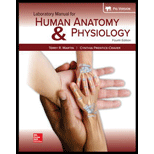
Concept explainers
Introduction:Hematocrit, hemoglobin content, coagulation and cholesterol are the tests commonly used to determine the blood composition. The obtained values are compared with the normal values to identifying various disease conditions.
Answer to Problem 1PL
Correct answer:
The correct answer is option (b) Hematocrit.
Explanation of Solution
Explanation/justification for the correct answer:
Option (b) Hematocrit. The hematocrit is the percentage of blood volume composed of red blood cells. When heparinized blood sample left undisturbed the heavier cellular component settles to the bottom of the tube. The red blood cells settle at the bottom as red layer is called compacted red blood cells. The percentage of compacted red blood cells in the blood sample is called hematocrit.So, the correct answer is option (b).
Explanation for incorrect answer:
Option (a) Hemoglobin. Hemoglobin is responsible for the binding of oxygen in red blood cells. Molecules of the protein hemoglobin compose about one third of the volume within red blood cell. The hemoglobin molecule is composed of four protein subunits, each containing a heme molecule with an atom of iron. Each iron binds to one oxygen molecule. As a result each hemoglobin molecule can bind to four oxygen molecule.So, this is an incorrect option.
Option (c) Buffy coat.When heparinized blood sample left undisturbed the heavier cellular component settles to the bottom of the tube. The red blood cells settle at the bottom as red layer is called compacted red blood cells.A thin, whitish layer known as buffy coat, forms on the top of compacted red blood celllayer. This contains the white blood cells and the platelets. So, this is an incorrect answer.
Option (d) Coagulation.The coagulation mechanism involves a series of chain reaction that results in a blood clot. The final stage of blood clot formation occurs when thrombin converts a soluble plasma protein called fibrinogen into insoluble threads of fibrin. The fibrin mesh traps the cellular components of the blood, stopping the blood loss. So, this is an incorrect answer.
Want to see more full solutions like this?
Chapter 42 Solutions
Laboratory Manual For Human Anatomy & Physiology
- Describe the principle of homeostasis.arrow_forwardExplain how the hormones of the glands listed below travel around the body to target organs and tissues : Pituitary gland Hypothalamus Thyroid Parathyroid Adrenal Pineal Pancreas(islets of langerhans) Gonads (testes and ovaries) Placentaarrow_forwardWhat are the functions of the hormones produced in the glands listed below: Pituitary gland Hypothalamus Thyroid Parathyroid Adrenal Pineal Pancreas(islets of langerhans) Gonads (testes and ovaries) Placentaarrow_forward
- Describe the hormones produced in the glands listed below: Pituitary gland Hypothalamus Thyroid Parathyroid Adrenal Pineal Pancreas(islets of langerhans) Gonads (testes and ovaries) Placentaarrow_forwardPlease help me calculate drug dosage from the following information: Patient weight: 35 pounds, so 15.9 kilograms (got this by dividing 35 pounds by 2.2 kilograms) Drug dose: 0.05mg/kg Drug concentration: 2mg/mLarrow_forwardA 25-year-old woman presents to the emergency department with a 2-day history of fever, chills, severe headache, and confusion. She recently returned from a trip to sub-Saharan Africa, where she did not take malaria prophylaxis. On examination, she is febrile (39.8°C/103.6°F) and hypotensive. Laboratory studies reveal hemoglobin of 8.0 g/dL, platelet count of 50,000/μL, and evidence of hemoglobinuria. A peripheral blood smear shows ring forms and banana-shaped gametocytes. Which of the following Plasmodium species is most likely responsible for her severe symptoms? A. Plasmodium vivax B. Plasmodium ovale C. Plasmodium malariae D. Plasmodium falciparumarrow_forward
- please fill in missing parts , thank youarrow_forwardplease draw in the answers, thank youarrow_forwarda. On this first grid, assume that the DNA and RNA templates are read left to right. DNA DNA mRNA codon tRNA anticodon polypeptide _strand strand C с A T G A U G C A TRP b. Now do this AGAIN assuming that the DNA and RNA templates are read right to left. DNA DNA strand strand C mRNA codon tRNA anticodon polypeptide 0 A T G A U G с A TRParrow_forward
 Medical Terminology for Health Professions, Spira...Health & NutritionISBN:9781305634350Author:Ann Ehrlich, Carol L. Schroeder, Laura Ehrlich, Katrina A. SchroederPublisher:Cengage Learning
Medical Terminology for Health Professions, Spira...Health & NutritionISBN:9781305634350Author:Ann Ehrlich, Carol L. Schroeder, Laura Ehrlich, Katrina A. SchroederPublisher:Cengage Learning Comprehensive Medical Assisting: Administrative a...NursingISBN:9781305964792Author:Wilburta Q. Lindh, Carol D. Tamparo, Barbara M. Dahl, Julie Morris, Cindy CorreaPublisher:Cengage Learning
Comprehensive Medical Assisting: Administrative a...NursingISBN:9781305964792Author:Wilburta Q. Lindh, Carol D. Tamparo, Barbara M. Dahl, Julie Morris, Cindy CorreaPublisher:Cengage Learning





